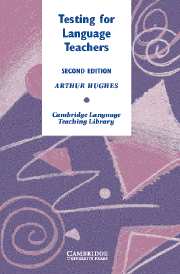Book contents
- Frontmatter
- Contents
- Acknowledgements
- Preface
- 1 Teaching and testing
- 2 Testing as problem solving: an overview of the book
- 3 Kinds of tests and testing
- 4 Validity
- 5 Reliability
- 6 Achieving beneficial backwash
- 7 Stages of test development
- 8 Common test techniques
- 9 Testing writing
- 10 Testing oral ability
- 11 Testing reading
- 12 Testing listening
- 13 Testing grammar and vocabulary
- 14 Testing overall ability
- 15 Tests for young learners
- 16 Test administration
- Appendix 1 The statistical analysis of test data
- Appendix 2 Item banking
- Appendix 3 Questions on the New Zealand youth hostels passage
- Bibliography
- Subject Index
- Author Index
2 - Testing as problem solving: an overview of the book
Published online by Cambridge University Press: 05 May 2010
- Frontmatter
- Contents
- Acknowledgements
- Preface
- 1 Teaching and testing
- 2 Testing as problem solving: an overview of the book
- 3 Kinds of tests and testing
- 4 Validity
- 5 Reliability
- 6 Achieving beneficial backwash
- 7 Stages of test development
- 8 Common test techniques
- 9 Testing writing
- 10 Testing oral ability
- 11 Testing reading
- 12 Testing listening
- 13 Testing grammar and vocabulary
- 14 Testing overall ability
- 15 Tests for young learners
- 16 Test administration
- Appendix 1 The statistical analysis of test data
- Appendix 2 Item banking
- Appendix 3 Questions on the New Zealand youth hostels passage
- Bibliography
- Subject Index
- Author Index
Summary
Language testers are sometimes asked to say what is ‘the best test’ or ‘the best testing technique’. Such questions reveal a misunderstanding of what is involved in the practice of language testing. A test that proves ideal for one purpose may be quite useless for another; a technique that may work very well in one situation can be entirely inappropriate in another. As we saw in the previous chapter, what suits large testing corporations may be quite out of place in the tests of teaching institutions. Equally, two teaching institutions may require very different tests, depending on the objectives of their courses, the purpose of the tests, and the resources available. Each testing situation is unique and sets a particular testing problem. And so the first step must be to state this testing problem as clearly as possible. Whatever test or testing system we then create should be one that:
consistently provides accurate measures of precisely the abilities in which we are interested;
has a beneficial effect on teaching (in those cases where the test is likely to influence teaching);
is economical in terms of time and money.
The first thing that testers have to be clear about is the purpose of testing in any particular situation. Different purposes will usually require different kinds of tests. This may seem obvious but it is something that is not always recognised.
Information
- Type
- Chapter
- Information
- Testing for Language Teachers , pp. 8 - 10Publisher: Cambridge University PressPrint publication year: 2002
